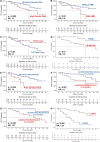Clinical Efficacy of Isatuximab Plus Carfilzomib and Dexamethasone in Relapsed/Refractory Multiple Myeloma Patients
- PMID: 39370303
- PMCID: PMC11613624
- DOI: 10.1111/ejh.14314
Clinical Efficacy of Isatuximab Plus Carfilzomib and Dexamethasone in Relapsed/Refractory Multiple Myeloma Patients
Abstract
Isatuximab, a novel anti-CD38 monoclonal antibody, is approved in combination with carfilzomib and dexamethasone (Isa-Kd) in relapsed/refractory multiple myeloma (RRMM) patients. Because of its recent introduction, real-world efficacy and safety are poorly reported. In this Italian multicenter real-life observational retrospective study, efficacy and safety of the Isa-Kd regimen were evaluated in a cohort of 103 RRMM patients. Overall response rate (ORR) was 85%, with stringent (sCR) or complete response (CR) in 18% of cases and very good partial response (VGPR) in 39%. Median PFS and OS were not reached within the study period, while 1-year PFS and OS were 72% and 77%, respectively. Hematological toxicities were observed in 42% of subjects, and cardiac toxicities occurred in 24% of cases. Moreover, we conducted a subanalysis on patients (N = 69) treated with Isa-Kd after one prior line of therapy, showing an ORR of 88%, with sCR + CR in 20% of subjects, VGPR in 46%, and PR in 22% of patients. In this group, median PFS and OS were not reached, while 1-year PFS and OS were 92% and 95%, respectively. In conclusions, our study confirmed Isa-Kd as an effective treatment option for RRMM with a manageable safety profile even in real-life settings.
Keywords: isatuximab; multiple myeloma; proteasome inhibitors; real life.
© 2024 The Author(s). European Journal of Haematology published by John Wiley & Sons Ltd.
Conflict of interest statement
The authors declare no conflicts of interest.
Figures


References
-
- Howlader N., Noone A. M., Krapcho M., et al., SEER Cancer Statistics Review, 1975–2016 (Bethesda: National Cancer Institute, 2019).
-
- Deaglio S., Mehta K., and Malavasi F., “Human CD38: A (r) Evolutionary Story of Enzymes and Receptors,” Leukemia Research 25, no. 1 (2001): 1–12. - PubMed
Publication types
MeSH terms
Substances
LinkOut - more resources
Full Text Sources
Medical
Research Materials

